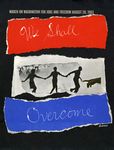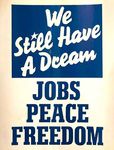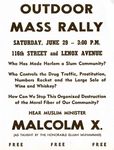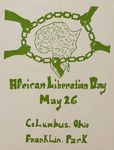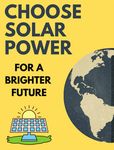Protest Banner Project 2021 - Village of Yellow Springs, Ohio
←
→
Page content transcription
If your browser does not render page correctly, please read the page content below
Protest Banner
Project 2021
For decades, residents of Yellow Springs have engaged in activism, often taking
to the streets to demand social change in support of critical issues related to
fighting racism, sexism, LGBTQ rights, and for environmental justice.
To honor this activist spirit, the Yellow Springs Arts and Culture Commission
presents a lampost banner series on Dayton Avenue and Xenia Avenue
representing submissions from community residents of protest posters used
during demonstrations over the years.
We wish to thank all the participants and the Village of Yellow Springs for their
support of this project.
Special Thanks to
The Village of Yellow Springs
National Afro-American Museum and Cultural Center,
Jim McKinnon, Archivist
Yellow Springs
Antiochiana, Antioch College, Scott Sanders, Archivist
Arts and Culture Commission
Chicago Women’s Graphic Collective Cheryl Durgans, Chair
Eve Diamond Amy Wamsley, Secretary
Clara-Lang Ezekiel Nya Brevik | John Fleming
Pat Fife Laurie Freeman | Catherine Roma
Catherine Roma Lisa Kreeger, Council Representative
Brian Housh, Council Alternate
Matt WalkerXENIA AVENUE - east side
Choose Solar Power
Texas-based company Vesper Energy has plans to build The Kingswood Solar Farm. If built this
solar farm could be the largest East of the Mississippi spanning more than 1,200 acres in Miami
Township, Xenia Township and Cedarville Township. Vesper Energy stated they plan to start
the application process in the beginning of 2021. Many local citizens have been divided over
this proposal for agricultural and financial reasons. This banner was submitted by Pat Fife who
created this sign in support of the project.
Rodney King
On March 3, 1991, King was beaten by LAPD officers. An uninvolved individual, George Holliday,
filmed the incident from his nearby balcony. The footage showed an unarmed King on the
ground being beaten after initially evading arrest. It was announced the four officers involved
would be disciplined, Los Angeles police chief Daryl Gates said: “We believe the officers used
excessive force taking him into custody. In our review, we find that officers struck him with
batons between fifty-three and fifty-six times.” The LAPD initially charged King with “felony
evading,” but later dropped the charge. On his release, he spoke to reporters from his wheelchair: a broken
right leg in a cast, his face badly cut and swollen, bruises on his body, and a burn area to his chest where he
had been jolted with a 50,000-volt stun gun. He said he was scared for his life as they drew down on him.
Four officers were eventually tried with three acquitted, and the jury failed to reach a verdict on one charge
for the fourth. Within hours, the 1992 Los Angeles riots started lasting for 6 days. The federal government
prosecuted a separate civil rights case, obtaining grand jury indictments of the four officers for violations of
King’s civil rights. Their trial in a federal district court ended with two of the officers being found guilty and
sentenced to prison. The other two were acquitted of the charges. In a separate civil lawsuit in 1994, a jury
found the city of Los Angeles liable and awarded King $3.8 million in damages. Poster courtesy of the Afro-
American Museum and Cultural Center.
Save Kids Not Guns
Created by 15 year old Eve Diamond who made the sign in March of 2018 for a March for Our
Lives at Wright State University. I thought it was a powerful statement that reflected how I felt
about the cause. I was very passionate about the movement because of how scared I was to go
to school every day in my seventh grade year following all the news about school shootings. I also
participated in the walk out protests at YSHS/MMS during the same year.
African Liberation Day
Poster Courtesy of the National Afro-American Museum and Cultural Center. African Freedom
Day was founded during the first Conference of Independent African States in Ghana on April 15,
1958. The purpose of the day was to annually mark the liberation movement’s progress and to
symbolize the determination of the people of Africa to free themselves from foreign domination
and exploitation. Between 1958 and 1963, 17 countries in Africa won their independence. On
May 25, 1963, 31 African leaders convened a summit meeting to find the Organization of African
Unity (OAU). They renamed Africa Freedom Day as “African Liberation Day” and changed its date to May 25.
The founding date of the OAU is also referred to as “Africa Day”. African Liberation Day has helped to raise
political awareness in African communities across the world. It has also been a source of information about
the struggles for liberation and development.
Trans Rights Are Human Rights
Trans rights are human rights and its important that we keep this issue in the conversation and
highly visible by Matt Walker. The term transgender describes people whose gender identity is
different than the sex they were assigned at birth. Transgender people are no less deserving
of rights and freedoms than anyone else however, transgender people face disproportionately
higher rates of human rights discrimination than any other community.XENIA AVENUE - WEst side
Angela Davis
From the collection of Catherine Roma. Angela Davis has been a shero of mine for a long while.
She’s radical, an academic, a prison abolitionist, a lesbian and fierce feminist . This now famous
Cuban silk screen says “Comite por la libertad de Angela Davis, Cuba.” Guns belonging to Davis
were used in an armed takeover of a courtroom where four people were killed. She was prosecuted
for 3 felonies, including conspiracy to murder and held in jail for over a year. Several protests took
place demanding her freedom. John Lennon and Yoko Ono contributed to the campaign with the song “Angela”.
We Still Have a Dream - Jobs, Peace, Freedom
This poster was used during on August 27, 1983 during the March on Washington. Usage allowed
due to the courtesy of the National Afro-American Museum and Cultural Center. The year 1983,
which was the twentieth anniversary of the March on Washington and Martin Luther King, Jr.’s “I
Have A Dream” speech offered a chance to consider how far African Americans had come in those
two decades, while also providing the opportunity to rally for new battles around race. A diverse
coalition of 250,000 Americans gathered. More than 700 groups with a wide range of political
and social agendas came to Washington demanding everything from government job programs to
a nuclear freeze to gay rights. But their unifying theme, aside from the march’s official call for “Jobs, Peace and
Freedom,” was unquestionably the goal of ousting President Reagan.
Take the Toys From the Boys: Women Oppose the Nuclear Threat (WONT)
From the collection of Catherine Roma. While doing research in London for my dissertation I joined
this march. The demonstrations began in the early 1980s at the Greenham Common Women’s
Peace Camp. Ancillary marches were held throughout England. Women protested against the
decision by the British Government to store cruise missiles there at Greenham. The women soon
decided protests were not enough and formed an encampment and blockade at the RAF base in
Greenham that lasted for 19 years.
John Lewis
John Robert Lewis was an American politician, statesman, and civil rights activist and leader who
served in the United States House of Representatives for Georgia’s 5th congressional district
from 1987 until his death in 2020. He participated in the “Freedom Rides” of 1961, was arrested
and beaten in Selma, Alabama fighting for voter rights of Black Americans, and on Sunday, March
7, 1965, in Selma, some 600 marchers lined up behind the Student Non-Violent Coordinating
Committee Chair. This march was organized to go from Selma, Alabama to the State capital in
Montgomery, 54 miles away, to protest the February 26 murder of Jimmy Lee Jackson by police and the denial of
voting rights. The police informed the marchers to turn back, but instead they knelt and John Lewis along with
many others was beaten and arrested. Lewis spent his life defending voter rights and humanitarian needs. In
2015, Lewis returned to Selma, Alabama for “America’s Journey for Justice” alongside Presidents Obama and
George W. Bush to commemorate the 50th anniversary of the incident upon the bridge. 5 years later atop the
Edmund Pettus Bridge in Selma, Lewis is quoted in saying, “Get in good trouble, necessary trouble, and help
redeem the soul of America.” Poster created by Clara Lang Ezekiel.
NAACP We March for Dignity and Justice
The National Association for the Advancement of Colored People was founded in 1909. For more
than 106 years, members of the NAACP have been the nation’s first responders to violence, bigotry,
racism, injustice and social unrest. In March 2015, “America’s Journey for Justice” to restore voting
rights in America took place. The 860 mile journey begin in Alabama and ended in Washington, D.C
to bring attention to the vulnerable communities who are victims of regressive voting rights tactics.
The march included a broad coalition of partners including the Democracy Initiative, Communications Workers
of America, Common Cause, NAACP Legal Defense Fund, Leadership Conference on Civil and Human Rights,
National Action Network, 1199 SEIU, The Lawyers’ Committee for Civil Rights Under Law, Sierra Club, National
Bar Association, and Black Women’s Roundtable and National Congress of Black Women. This poster was
courtesy of the Afro-American Museum and Cultural Center.Dayton Street
We Shall Overcome March on Washington for Jobs and Freedom August 28, 1963
This work was created by Anna Arnold Hedgeman (July 5, 1899 – January 17, 1990) . She was
an African American civil rights leader, politician, educator, and writer. After being the executive
director of Harry Truman’s 1948 presidential campaign, Hedgeman was rewarded with a federal
appointment in the Health, Education, and Welfare Department in the president’s administration.
In 1954, she became the first African American woman to hold a mayoral cabinet position in the
history of New York City. She was the only woman among the organizers of the 1963 March on Washington.
Hedgeman individually recruited 40,000 protesters to participate. In 1966 she became a co-founder of the
National Organization for Women. Her work was donated for use courtesy of the National Afro-American
Museum and Cultural Center.
Male Chauvinism and Imperialistic War Make Profits and Maim People
From the collection of Catherine Roma. Early poster linking the Vietnam War and Women’s
Liberation from the Womens Graphic Collective-Chicago Womens Liberation Union 1972. The
scope of women’s activism and mobilization included cultural heritage/legacy, attributes of care,
patience and perseverance, not only their substantial participation on the battlefronts, but also
campaigns focused on caring for troops. Their domestic roles as wives, daughters, or mothers were
strong because they were the ones who provided patient and tenacious protection of the family and, at large,
the defense of the nation.
Our Planet Our Lives
From the collection of Catherine Roma. The World House Choir sang Missa Gaia (Earth Mass) in
September 2019 at the Antioch College’s Foundry Theatre. Participants included the Dayton Con-
temporary Dance Company, local vocal soloists and 8 instrumentalists (was also performed at the
Levitt in Dayton and in Springfield). The image you see of the planet is a 1850 map superimposed
over the NASA image of the Great Lakes. The 1850 map includes the cities and counties where
Missa Gaia was performed. Guest lecturer Dr. Chris Cuomo (University of Georgia) presented environmental pro-
grams: “Refusing Fatalism: Realistic Approaches to Achieving Climate Justice” at Antioch and “Good Allies in the
Struggle for Climate Justice: Indigenous Sovereignty and Feminist Methods.” at Wright State University.
Outdoor Mass Rally - Malcolm X
Courtesy of the National Afro-American Museum and Cultural Center. After several racial tragedies
and setbacks in his youth, Malcolm Little changed his name to Malcolm X and later found the Is-
lamic religion. It was in 1954, when Malcolm X was appointed the chief minister of Harlem’s Temple
No. 7 by Elijah Muhammad. The next several years were filled with racial discrimination including
the police beating of member Johnson Hinton where he was refused medical attention. Malcolm
joined the contingent of Muslims at the 28th Precinct headquarters in Harlem, where he demanded
Hinton receive medical attention. Media coverage of the Hinton incident brought national attention,
and as a result the FBI now consider him a “key figure” meriting surveillance and increased harassment. This
speech took place in Harlem on June 29, 1963. One year before Malcolm X’s pilgrimage to Mecca changing
his worldview and fundamental understanding of race relations, religion, and the world at large. “And if I can
die having brought any light, having exposed any meaningful truth that will help to destroy the racist cancer
that is malignant in the body of America — then all of the credit is due to Allah. Only the mistakes have been
mine.” Malcolm X
Gegner’s Barber Shop Protest 1964
Hundreds of area students, residents and law enforcement officials jammed downtown Yellow
Springs on Xenia Avenue during a chaotic demonstration against Gegner’s Barber Shop due to
barber Lewis Gegner refusing to give African-Americans haircuts. Top photo on the banner from
left, Arthur Morgan, Paul Graham, an unidentified man, Walter Anderson and Hardy Trolander
(partially hidden) leading a march. Photos by Axel Bahnsen courtesy of Antiochiana, Antioch
College.You can also read




